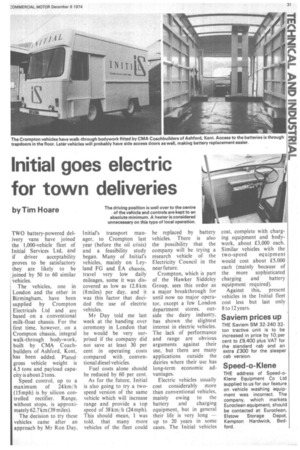Initial goes electric for town deliveries
Page 33

If you've noticed an error in this article please click here to report it so we can fix it.
by Tim Hoare
TWO battery-powered delivery vans have joined the 1,000-vehicle fleet of Initial Services Ltd, and if driver acceptability proves to be satisfactory they are likely to be joined by 50 to 60 similar vehicles.
The vehicles, one in London and the other in Birmingham, have been supplied by Crompton Electricals Ltd and are based on a conventional milk-float chassis. For the first time, however, on a Crompton chassis, integral walk-through body-work, built by CMA Coachbuilders of Ashford, Kent, has been added. Plated • gross vehicle weight is 4.5 tons and payload capacity is about 2 tons.
Speed control, up to a maximum of 24 km / h (15 mph) is by silicon controlled rectifier. Range, without stops, is approximately 62.7 km (39 miles).
The decision to try these vehicles came after an approach by Mr Ron Day, Initial's transport manager, to Crompton last year (before the oil crisis) and a feasibility study began. Many of Initial's vehicles, mainly on Leyland FG and EA chassis, travel very low daily mileages, some it was discovered as low as 12.8 km. (8 miles) per day, and it was this factor that decided the use of electric vehicles.
Mr Day told me last week at the handing over ceremony in London that he would be very surprised if the company did not save at least 30 per cent in operating costs compared with conventional diesel vehicles.
Fuel costs alone should be reduced by 60 per cent.
As for the future, Initial is also going to try a twospeed version of the same vehicle which will increase range and provide a top speed of 38 km/ h (24 mph). This should mean, 1 was told, that many more vehicles of the fleet could be replaced by battery vehicles. There is also the possibility that the company will be trying a research vehicle of the Electricity Council in the near future.
Crompton, which is part of the Hawker Siddeley Group, sees this order as a major breakthrough for until now no major operator, except a few London department stores, outside the dairy industry, has shown the slightest interest in electric vehicles. The lack of performance and range are obvious arguments against their use, but there are many applications outside the dairies where their use has long-term economic advantages.
Electric vehicles usually cost considerably more than conventional vehicles, mainly owing to the battery and charging equipment, but in general their life is very long — up to 20 years in some cases. The Initial vehicles cost, complete with charging equipment and bodywork, about £3,000 each. Similar vehicles with the two-speed equipment would cost about £5,000 each (mainly because of the more sophisticated charging and battery equipment required).
Against this, present vehicles in the Initial fleet cost less but last only 8 to 12 years.
Saviem prices up
THE Saviem SM 32-240 32ton tractive unit is to be increased in price by 10, per cent to £9,400 plus VAT for the standard cab and an extra £300 for the sleeper cab version.
Speed-o-Klene
THE address of Speed-oKlene Equipment Co Ltd supplied to us for our feature on vehicle washing equipment was incorrect. The company, which markets Euroclean equipment, should be contacted at: Euroclean, Elstow Storage Depot, Kempton Hardwick, Bedford.












































































































































